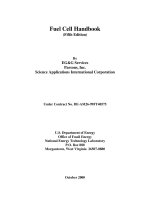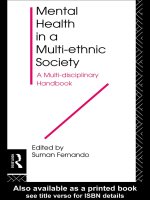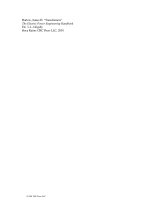Welding Pipeline Handbook docx
Bạn đang xem bản rút gọn của tài liệu. Xem và tải ngay bản đầy đủ của tài liệu tại đây (1.33 MB, 63 trang )
INTRODUCTION 3
Joint details 4
Joint types 5
Electrode positioning angles 6
Pipe classification 7
Consumption of electrodes 11
ASME / EN positions 13
THE MANUAL METAL ARC
PROCESS
15
General information 16
Filler materials 17
Pipeweld cellulosic electrodes 17
Basic electrodes 19
Basic electrodes - Technical data 20
Cellulosic electrodes - Technical dfata 22
WELDING TECHNIQUES
AND OPERATIVE PRACTICES
25
General information 26
Pipe welding in vertical down (downhill)
with cellulosic electrodes
1 - Preparation and tacking 27
2 - Joint in 5G/PG position 29
3 - Joint in 6G/H-L045 position 35
Welding of pipes in vertical up (uphill)
with mixed cellolosic/basic technique
1 - Preparation and tacking 38
2 - Joint in 5G/PF position 40
3 - Joint in 2G/PC position 44
4 - Jioint in 6G/H-L045 position 47
DEFECTS: CAUSES AND REMEDIES 49
AUTOMATIC PIPE WELDING 53
General information 54
Filler materials 55
Welding techniques and operational practices 57
Examples of WPS 58
Comparison between three welding methods 62
Defects and remedies 63
List of contents
1
2
Presentation
Every day countless kilometres of steel pipelines are installed
worldwide for the most varied civil and industrial uses.
They form real networks comparable to a system of road networks,
which, although not so obvious, are definitely much more intricate and
carry fluids that have become essential for us.
To comply with technical specifications and fulfil the necessary safety
requisites, special materials and welding processes which have
evolved with the sector have been developed in recent years.
The main welding process used to install the pipelines is
manual
welding with coated electrode
, which, thanks to its ease and
versatility, is still the one most used.
However, to limit costs and increase welding productivity, particularly
on long routes, various constructors have adopted the semi-automatic
or completely automatic
welding process with solid wire or wire
flux coated with gaseous protection
.
This handbook describes both methods. Ample space has been
dedicated, in particular, to manual welding, with particular reference to
the operative practice and quality assessment, due to its considerable
use still today, but not neglecting more modern and productive
methods which will be increasingly used in future.
The presumption of this work is to be able to satisfy the most
demanding technician and welder, but, in particular, to supply each
user with useful information and a solid operative basis, as regards
the processes and filler materials and the welding equipment.
INTRODUCTION
Butt Joint
1. Root gap: separation between the edges to be welded
at the root of the joint
2. Root face: surface of the joint preparation
perpendicular to the surface of the plate
3. Bevel surface: oblique surface of the joint preparation
4. Bevel angle: angle between the bevelled surface and
a plane perpendicular to the plate
5. Included angle: total angle between the two bevel
surfaces
6. Seam width: effective width of the joint (distance
between the bevels plus depth of penetration). The
width of the calking iron seam and groove iron are the
same thing
7. Thickness of the plate
Fillet Joint
1. Throat thickness: distance between seam root and
surface measured on the bisector of the angle
2. Leg lenght: distance between seam root and edge
3. Joint root: point in which the bottom of the seam
intersects the surface of the base metal
4. Joint edge: junction point between seam surface and
base metal surface
5. Joint surface: external surface of the seam
6. Fusion depth: depth reached by the fusion bath from
the surface of the base metal
7. Seam width: distance between the joint edges
Joint details
4
Many other variations are possible.
5
1. Butt joint
without bevel
2. Butt joint
with V bevel
3. Butt joint
with X bevel
4. Butt joint
with unilateral
bevel
5. Butt joint
with double
unilateral bevel
6. Butt joint
with U bevel
7. Butt joint
with double
U bevel
8. Butt joint
with J bevel
9. Butt joint
with double
J bevel
10. Fillet joint 11. Double fillet joint
Joint types
In this handbook the official AWS method is used to
define the positioning angles of the electrodes
(EN added).
Two angles are indicated: the feed angle and the work
angle.
The feed angle is called “TO BE PUSHED” when the
electrode points in the feed direction.
The feed angle is called “TO BE PULLED” when the
electrode points in opposite direction to the feed.
The work angle is given in relation to a reference plane
or work plane.
The figures illustrate the definition method of the angles.
Taking the clock face as reference, 1 minute corresponds
to 6°.
WORK PLANE
FEED
WELDING AXIS
FEED PLANE
ANGLE TO BE PULLED
ANGLE TO BE PUSHED
WORK PLANE
F
E
E
D
P
L
A
N
E
A
N
G
L
E
T
O
B
E
P
U
S
H
E
D
A
N
G
L
E
T
O
B
E
P
U
L
L
E
D
FEED
WELDING AXIS
W
ORK PLANE
SYMMETRY AXIS
SYM
M
ETRY AXIS
FEED PLANE
FEED
ANGLE TO BE PUSHED
ANGLE TO BE PULLED
Electrode positioning angles
6
Vertical
Horizonal
Pipe classification
Non-welded and welded pipes sized in accordance with ANSI B 36.10 and API standards
7
Prescriptions concerning the results of the traction and bending test for thicknesses ≤
25mm
1
, and for the hydrostatic test
8
Designation of the steels Pipe body Welding seam Pipe
(unwelded and welded pipes)
HFW, SAW, SAW, COW
COW
Alphanumeric Numeric Unitary yielding Tensile Elongation
3
Tensile Diameter of Hydrostatic
point strength (
L
0
= 5,65√S
0
strength the spindle test
for bending
R
10,5
R
m
R
10,5
/R
m
2
AR
m
test
4
(see 8.2.3.5) (see 8.2.3.8)
MPa MPa % MPa
min. max. min. min.
L245NB 1.0457
from 245 to 440 415
0,80
22 3
T
L245MB 1.0418 0,85
L290NB 1.0484
from 290 to 440 415
0,80
21 3
T
L290MB 1.0429 0,85
L360NB 1.0582 0,85
L360QB 1.8948 from 360 to 510 415 0,88 20 4
T
L360MB 1.0578 0,85
L415NB 1.8972 0,85
L415QB 1.8947 from 415 to 565 420 0,88 18 5
T
L415MB 1.8973 0,85
L450QB 1.8952
from 450 to 570 535
0,90
18 6 T
L450MB 1.8975 0,87
L485QB 1.8955
from 485 to 605 570
0,90
18 6 T
L485MB 1.8977 0,90
L555QB 1.8957
from 555 to 675 625
0,90
18 6 T
L555MB 1.8978 0,90
1
The mechanical features of pipes with greater thickness values of up to 40mm must be agreed.
2
The values of the ratio between the unitary yield point and the tensile strength are applied for the “pipe” product.They cannot be requested for the
starting material.
3
These values are applied for transversal samples withdrawn from the body of the pipe. If longitudinal samples are tested, the elongation values
must be increased by 2 units.
4
T = prescribed pipe thickness.
The same va-
lues as the pipe
body are ap-
plied.
Each pipe must
take the test
without showing
losses or visible
deformations
Outside diameters and preferential thicknesses (indicated in the framed zone of the table,
including the frame itself)
Outside Thickness
diameter mm
mm 2,3 2,6 2,9 3,2 3,6 4 4,35 5 5,6 6,3 7,1 8 8,8 10 11 12,5 14,2 16 17,5 20 22,2 25 28 30 32 36 40
33,7
42,4
48,3
60,3
88,9
114,3
168,3
219,1
273
323,9
355,6
406,4
457
508
559
610
660
711
762
813
864
914
1 016
1 067
1 118
1 168
1 219
1 321
1 422
1 524
1 626
9
10
Mechanical features / Chemical compositions (A.P.I. steels)
A.P.I.
Mechanical propr. N/mm
2
Chemical composition %
Carbonium
specification
Quality Yielding Tensile Carbon Manganese
(max)
point strength (max) (max)
equivalent
11
Consumption of electrodes
Pipeweld electrodes consumption (kg) in downhill vertical
12
Pipeweld electrodes consumption (kg) in uphill vertical
Note: for pipes of less than 152mm (6”) diameter, with wall thickness up to 6.4mm, Pipeweld 6010, diameter 2.5mm, may be used for the first bead.
Approximate weight of Pipeweld electrodes
Ø 3.25 approx. 28 grams
Ø 4.25 approx. 40 grams
Ø 5.25 approx. 62 grams
13
1G/1F (PA)
2G (PC)
3G/3F
1F (PA)
2F (PB)
3G/3F
4G
(PE)
5G
6G
PG - DOWNHILL
PF - UPHILL
PG - DOWNHILL
PF - UPHILL
PG - DOWNHILL
PF - UPHILL
(H-LO45)
ASME/EN positions
PROCESS
16
General information
The main welding process used to weld pipelines is the
MMA method, manual welding with coated electrodes.
There are many reasons for this choice. The first is the
most obvious: the manual electrode is the first product
invented that is suitable for arc welding.
However, still today, when more sophisticated materials
and more productive and less expensive techniques are
at the users’ disposal, MMA welding remains a favoured
process to weld pipes. Its easy use, capacity to reach
positions of difficult accessibility, the simplicity of the
necessary generators (or the fact of being able to use
motor generators; network power is not always available
on installation sites), the fact that protective gases
(difficult to find in certain countries, in particular third
world countries), necessary in welding with solid or cored
wires, are not required, all these and others are the
reasons for this choice.
Some classes of cellulosic and basic electrodes have
been specially designed to meet the requirements of the
grade of steel used to manufacture the pipeline and the
safety specifications laid down by standards, but also to
equip the user i.e. welders with versatile products created
for this specific purpose.
Care and storage of cellulosic electrodes
Cellulosic electrodes need a definite amount of moisture,
normally between 3% and 9%, to give satisfactory
operation. Over drying this type of electrode will lead to
charring of the organic material within the coating.This
can give un-satisfactory welding performance, loss of arc
voltage and weld metal porosity. These types of
electrodes should NOT be re-dried.
Tin-Pac for transport and stockage in heavy
environments
The ESAB range of consumables for pipeline welding
has been developed to match the steel qualities and the
demands from the pipeline industry for reliable, easy to
17
OK PIPEWELD CELLULOSIC
ELECTRODES
OK Pipeweld electrodes have always been a safe and
productive solution in the welding of pipelines.
Features
• High Cellulose content in the electrode provides an
intense arc good penetration in all positions.
• High Cellulose content gives small slag covering of the
weld bead, although it is easily re-melted it is advisable
to remove before welding the next bead.
• The thin coating combined with the penetrating arc
enables a smaller root gap to be utilised and the
complete joint requires less weld metal to be
deposited.
• The rapid solidification of the weld metal allows truly all
positional welding
Recommended current ranges for the different
welding positions.
Welding equipment
The welding generators that can be used with OK
Pipeweld need to have a relatively high open circuit
voltage (OCV > 65V) and good dynamic characteristics.
This prevents the arc snapping out during the welding
operation.
Filler materials
use highly productive consumables. Our resources in
research and development around the world have made
it possible not only to meet the demands of today but
also to foresee the needs for tomorrow. Cellulosic
electrodes from ESAB are used for root pass, filling and
capping on a wide range of steels used in the pipeline
industry and pipework production.
ESAB Electrode Choice for each Bead Position
18
Pipe steel Root or
Hot pass Hot fill
Filler
Capping
and grade stringer passes
5L, A25 •••••
5L, 5LS, A •••••
5L, 5LS, B •••••
5LS, 5LX42 •••••
5LS, 5LX46 •••••
5LS, 5LX52 • ◊ • ◊◊◊◊
5LX56 • ◊ • ◊◊◊◊
5LX60 • ❋ • ❋❋❋❋
5LX65 • ❋ • ❋❋❋❋
5LX70 • ❋ • ❋❋❋❋
• = Pipeweld 6010 Plus
◊ = Pipeweld 7010
❋ = Pipeweld 8010
DOWNHILL VERTICAL
POSITION
UPHILL VERTICAL
POSITION
FINAL BEAD
ROOT PASS FILLING BEAD
1,2 ÷ 1,6 2,5 ÷ 3,2
19
BASIC ELECTRODES
When the pipeline steel has a strength higher than X70
the need of preheat and post weld heat treatment
becomes more stringent and the choice of using basic
electrodes offers advantages. The reason is, of course
the high amount of hydrogen in the weld metal from
cellulosic electrodes. The hydrogen is a greater risk for
cracks in high strength material, because of the
increased sensitivity to hardening in these steels.
The properties of the basic electrodes also mean much
better impact properties at low temperatures.
The disadvantage with basic electrodes welded vertically
up is the low current that has to be used resulting in low
productivity.
This can be avoided by using basic electrodes developed
specially for welding of pipelines in the vertical-down
position. These electrodes contain iron powder in the
coating and therefore have higher productivity than
cellulose electrodes since they also can be welded at
higher currents than cellulose electrodes.
Productivity is 25-30% higher than for cellulose
electrodes and 40-50% higher than for basic electrodes
in vertically up welding.
In the root, the penetration and force from a cellulose
electrode is however the most productive process since
they can manage a small root-opening with high current
resulting in fast progression. A basic electrode can be
used also for the root but requirements on alignment will
be higher because of the less forceful arc.
The best procedure for welding high strength pipelines is
therefore to use cellulose electrodes for the root pass and
basic vertical down electrodes for filling and capping passes.
The higher quality of the basic weld metal is
advantageous when a pipeline is exposed to stress.
When, during its route, an underground pipe (medium
and large diameters) crosses roads and railways, when
greater static and dynamic stress exists for external
reasons or when the pipes of medium and small
diameter are submitted to high temperatures, strong
pressure and vibration (heating plants, refineries etc.), it
is normally preferred to carry out the first bead with
Pipeweld and the filling with a basic electrode.
With this, the complete penetration that only Pipeweld
can guarantee and the maximum tenacity of the joint due
to the electrode with basic coating are obtained.
Some mechanical characteristics, in particular the values
of toughness and strength, were improved.
OK 48.00 is classified E 7018-1; this means that it
supplies resiliency values of over 27j at –46°C, thanks to
the purity of its components, in an even better developed
formula.
It can be used to weld steels with high values of
equivalent carbon and/or high elastic limit thanks to the
laying which guarantees values of diffusible hydrogen of
≤ 5 ml/100 gr. and consequently makes the risk of cold
cracks practically non-existent, also permitting a
reduction of the pre-heating temperature required for the
basic electrodes. In addition to these metallurgical and
productive aspects that are important for the constructor,
there is improved welding capacity. The excellent starting
and restarting, the constant and regular fusion and the
fine aspect of the weld seam in all positions are
characteristics of fundamental importance for the welder
and guarantee a high productivity.
The VacPac boxing (plastic inner box with Vac Packed
aluminium foil hermetically sealed) ensures these
characteristics, over a long time and allows the product
to be used without redrying.
A.P.I. Quality Suggested Electrode
Specification First root Filling
5L A 25 Pipeweld 6010 OK 48.00
5L – 5LS A Pipeweld 6010 OK 48.00
5L – 5LS B Pipeweld 6010 OK 48.00
5LX X42 Pipeweld 6010 OK 48.00
5LX X46 Pipeweld 6010 OK 48.00
5LX X52 Pipeweld 6010 OK 48.00
5LX X56 Pipeweld 6010 OK 48.00
5LX X60 Pipeweld 6010 OK 48.00
5LX X65 Pipeweld 6010 OK 74.70
5LX X70 Pipeweld 6010 OK 74.70
20
Basic electrodes for steels with medium
and high yield strength
Electrode type OK 48.00 OK 53.70 OK 74.70
Coating Basic Basic Basic
Classifications
Recovery 115 115 115
Mechanical properties
All weld metal
analysis wt %
Applications
Welding Current DC+ AC, DC+(–) DC+
Welding parameters
Ø Amp
2.5 60 ÷ 90
3.2 90 ÷ 130
4 140 ÷ 180
5 190 ÷ 220
Ø Amp
2.5 60 ÷ 90
3.2 80 ÷ 130
4 115 ÷ 190
5 180 ÷ 290
Ø Amp
2 50 ÷ 80
2.5 70 ÷ 100
3.2 90 ÷ 140
4 120 ÷ 180
5 180 ÷ 230
Electrode used for welding
high tensile low alloyed
steels API 5L X60, X65, X70
A low hydrogen AC/DC
electrode for one side
welding of pipes and gen-
eral structure. The root
penetration is good, leav-
ing a flat bead with easy
removable slag. Suitable
for welding of pipeline up to
API 5L X56 it is aiso suit-
able for root pass welding
up to API 5L X80
Electrode suitable for weld-
ing in all positions of carbon
steels with medium and
high yeld strength. The low
hydrogen content in the
deposited metal minimises
the risk of cracks. Excellent
radiographic qualities. For
naval constructions, struc-
tural fabrication, boilers
, etc.
Excellent welding aspect
also in a vertical position.
R ≥ 510 MPa
S ≥ 420 MPa
A ≥ 26%
KV ≥ 48J at – 40° C
KV ≥ 27J at – 46° C
C ≤ 0.06 ÷ 0.1
Mn ≤ 1.3 ÷ 1.6
Si ≤ 0.25 ÷ 0.50
Mo 0.3 ÷ 0.5
R ≥ 550 MPa
S ≥ 430 MPa
A ≥ 26%
KV ≥ 150J at – 20° C
KV ≥ 100J at – 46° C
C ≤ 0.04 ÷ 0.08
Mn ≤ 0.95 ÷ 1.35
Si ≤ 0.3 ÷ 0.6
Ni < 0.1
R ≥ 510 MPa
S ≥ 420 MPa
A ≥ 26%
KV ≥ 48J at – 40° C
KV ≥ 27J at – 46° C
C ≤ 0,10
Mn ≤ 1,60
Si ≤ 0,60
AWS A/SFA 5.5:
E8018-G
EN 499:
E46 Mu Mo B 32
AWS A/SFA 5.1:
E7016-1
EN 499:
E42 5 B 12 H5
ISO 2560:
E51 5 B 24 H
AWS A/SFA 5.1:
E7018-1
EN 499:
E42/46 4 B 42 H5
ISO 2560:
E51 5 B 120 20 H
21
Basic electrodes for vertical-down
welding
Electrode type Filarc 27P Filarc 37P Filarc 108MP
Coating Basic Basic Basic
Classifications
Recovery 120 120 120
Mechanical properties
All weld metal
analysis wt %
Applications
Welding Current DC+ DC+ DC+
Welding parameters
Ø Amp
3.2 110 ÷ 150
4 180 ÷ 220
4,5 230 ÷ 270
Ø Amp
3.2 110 ÷ 150
4 180 ÷ 220
4,5 230 ÷ 270
Ø Amp
2.5 80 ÷ 100
3.2 110 ÷ 150
4 180 ÷ 220
4,5 230 ÷ 270
Suitable for welding high
strength pipe steels such
as API 5LX80.
Performance and produc-
tivity is similar to Filarc
27P.
Suitable for welding high
strength pipe steels such
as API 5LX75.
Performance and produc-
tivity is similar to Filarc
27P.
Filarc 27P is specially desi-
gned for downhill welding of
circumferential welds joints
in pipes. Suitable for pipe
steels API 5LX52 – X70
TS > 690 MPa
YS > 620 MPa
A
5
≥ 22%
C: 0,06-0,09
Si: 0,30-0,70
Mn: 1,6-2,0
Ni: 1,30-1,60
TS > 620 MPa
YS > 550 MPa
A
5
≥ 24%
C: 0,06-0,09
Si: 0,30-0,70
Mn: 1,0-1,4
Ni: 0,6-0,99 1,0
Mo: 0,3-0,6
TS > 550 MPa
YS > 460 MPa
A
5
≥ 25%
C: 0,06-0,09
Si: 0,30-0,70
Mn: 1,0-1,4
AWS A/SFA 5.5:
E10018-G
EN 757:
E55 4 Z B 41 H5
AWS A/SFA 5.5:
E9018-G
EN 499:
E55 5 1NiMo B 41 H5
AWS A/SFA 5.5:
E8018-G
EN 499:
E46 5 B 41 H5
22
Cellulosic electrodes for pipes
Electrode type Pipeweld 6010 PLUS
Pipeweld 7010
Coating Cellulosic Cellulosic
Classifications
Recovery 90 90
Mechanical properties
All weld metal analysis wt %
Applications
Welding Current DC+(-) DC+
Welding parameters
Ø Amp
3.2 60 ÷ 110
4 90 ÷ 140
5 110 ÷ 170
Ø Amp
2.5 60 ÷ 80
3.2 80 ÷ 140
4 100 ÷ 180
5 150 ÷ 250
Electrode suitable for welding in all
positions of pipes in steel type API
5LX – X63 – X65 – X70. Easy to
use, smooth running and penetrat-
ing. Particularly suitable for welding
on site, in downhill and overhead.
Excellent radiographic qualities.
Electrode suitable for welding of root
pass on every API 5L grade pipe,
designed for vertical down DC –
(main line welding)
R ≥ 560 MPa
S ≥ 480 MPa
A ≥ 20%
KV ≥ 27J at – 30° C
C
р 0,12
Mn 0,30 ÷ 0,60
Si
р 0,30
Ni 0,50 ÷ 0,80
Mo 0,10 ÷ 0,25
R ≥ 420 MPa
S ≥ 350 MPa
A ≥ 22%
C
р 0,13
Mn
р 0,4
Si
р 0,25
AWS A/SFA 5.5:
E7010-G (P1)
EN 499:
E42/3 Z C 21
ISO 2560:
E51 4 C 10
AWS/SFA 5.1:
E6010
EN 499:
E 38/3 C 21
23
Pipeweld 8010
Pipeweld 9010
Cellulosic Cellulosic
90 90
DC+(-) DC+
Ø Amp
3.2 60 ÷ 110
4 90 ÷ 140
5 110 ÷ 170
Ø Amp
3.2 60 ÷ 110
4 90 ÷ 140
5 110 ÷ 170
Electrode suitable for welding in all
positions of pipes in steel type API
5LX – X65 – X70 – X75 – X80.
Easy to use, smooth running and
penetrating. Particularly suitable for
welding on site, in descending ver-
tical and overhead. Excellent radi-
ographic qualities.
Electrode suitable for welding in all
positions of pipes in steel type API
5LX – X63 – X65 – X70. Easy to
use, smooth running and penetrat-
ing. Particularly suitable for welding
on site, in downhill and overhead.
Excellent radiographic qualities.
R ≥ 630 MPa
S ≥ 540 MPa
A ≥ 18%
KV ≥ 27J at – 30° C
C
р 0,12
Mn
р 1,0
Si
р 0,30
Ni 0,60 ÷ 0,80
Mo 0,20 ÷ 0,30
R ≥ 560 MPa
S ≥ 480 MPa
A ≥ 20%
KV ≥ 27J at – 30° C
C
р 0,12
Mn 0,30 ÷ 0,60
Si
р 0,30
Ni 0,50 ÷ 0,80
Mo 0,10 ÷ 0,25
AWS A/SFA A5.5:
E9010-G
EN 499:
E50 3 Z C 21
AWS A/SFA 5.5:
E8010-G (P1)
EN 499:
E46/3 Z C 21
OPERATIVE PRACTICES









